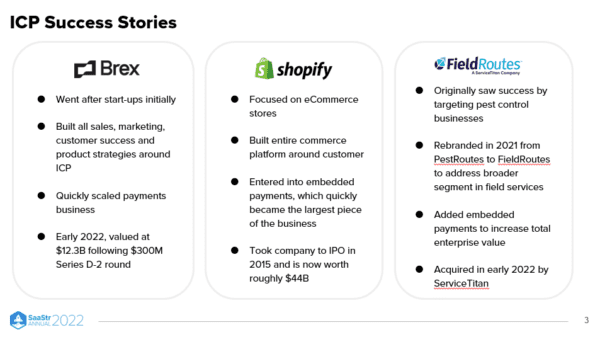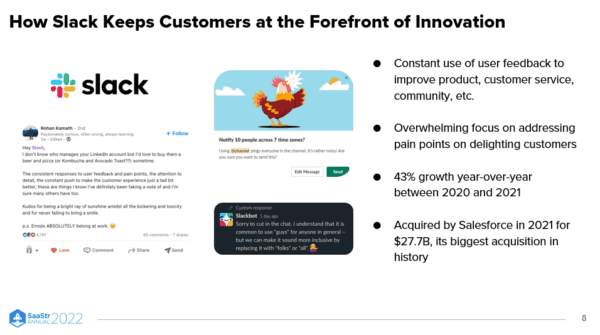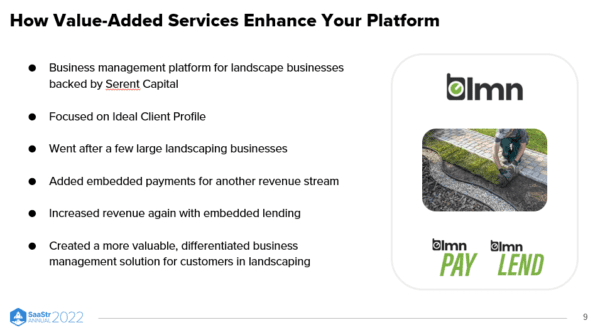Wherever you are in your revenue journey, adopting certain growth strategies can help you keep growing fast.
Robert Butler, Chief Commercial Officer at Payrix, has spent over 25 years in fintech and has most recently grown Payrix from $4 million to $100 million in ARR over the last four years, leading to a successful buyout and the launch of Worldpay for Platforms. Joined by Katie Wickham, Payrix’s Director of Marketing, Butler shares essential tips on accelerating your business to $100 million ARR and beyond.
Tip #1: Maintain a hyper-focus on your ideal client profile.
The demographic, environmental, and behavioral attributes of companies you expect to be your most valuable customers make up your ideal client profile (ICP).
Finding your ICP starts with broad strokes, finding a few customers, and talking to prospects. Through qualitative and quantitative analysis, your team can then narrow down to a sharper ICP.
Understanding your ICP is a foundational and organization-wide decision because it impacts your downstream sales and marketing efforts.
“Build your sales, marketing, customer success, and product development efforts around the needs of your ideal client.”
An ICP aligns your product, sales, marketing, service, and executive teams to all focus on your highest-value accounts. This helps your business get to a place where you can create scalable and repeatable tactics that will engage and convert your ICP.

Spotlighting the success of an ICP-focused strategy
Let’s examine how an ICP focus has helped two businesses win in a competitive marketplace.
Brex identified start-ups and technology companies struggling to find credit as its ICP and built their sales, marketing, customer success, and product strategies around this. Brex then scaled its payments business quickly. In five years, they went from a $120,000 pre-seed round to a series D at a $12 billion valuation in early 2022.
Shopify identified its ICP as individuals and businesses looking for easy tools to start an online e-commerce store. Then, it built an entire ecosystem around it, soon launching Shopify payments, an embedded payment tool that quickly became the largest piece of the business. Shopify took the company to IPO in 2015 and today has a market cap of about $40 billion.
A laser-sharp focus on the ideal client led these businesses to success.
Tip #2: Develop and execute an anchor tenant strategy.
Just like a boat needs an anchor, your SaaS process does too. Think of an anchor tenant as reinforcement or added security. Find a few customers, do everything you can to execute for them, and build strong relationships. These customers are your most important tenants and ones you can’t afford to lose.
“Delight customers. Form advocates. Leverage anchor tenants to extend trust into the market.”
The anchor tenant strategy is best understood with the analogy of a mall. Every mall has somewhere between three to eight anchor tenants. These are the retailers that draw in all the other retailers. In the 1990s, it was JC Penney and Sears. In the 2000s, it is Nordstrom and Macys.
SaaS companies can benefit from focusing on a few customers, helping them grow, and making them marquee customers. Having anchor tenants allows you to sharpen your ICP, all while creating a referral source of additional business.
Anchor tenant strategy in action at Payrix
Payrix identified its ICP, engaged with a few clients, and leveraged those relationships to grow its customer base. Once Payrix had a cookie-cutter ICP, they could pursue platforms that fit the mold. They delighted their targets and built a strong relationship, making them advocates of Payrix.
This benefited Payrix in several ways. Payrix could call on them as references, and get input on brand strategy and content like blogs, customer stories, podcasts, and whitepapers. In the first year, Payrix signed eight platforms; by the time the company exited, they were onboarding 8-10 platforms a month, and the number has grown exponentially.
Tip #3: Scale with customer-centric innovation.
Once you’ve understood your customers and built relationships with them, use it to your advantage. You know your customers’ challenges, goals, and personal and professional motivators. Use the opportunity to continue making your customer the hero and focus on customer-centric innovation.
Value-added services like embedded payments, lending, or banking offer your platform more revenue and are also attractive to potential investors. It increases total enterprise value, lowers customer acquisition costs, and boosts net revenue retention.

Winning with customer-centric innovation
Slack and LMN are examples of companies that put customer-centric innovation at the heart of their business.
Slack uses user feedback to improve every aspect of the business. This overwhelming focus on addressing pain points and delighting customers has resulted in measurable success, with the company witnessing a 43% year-on-year growth between 2020- 2021. In 2021, Slack was acquired for a whopping $2.7 billion, the biggest acquisition in Salesforce history.
LMN offers end-to-end CRM for landscaping professionals. LMN focuses on innovating for the needs of large and small businesses. With value-added features like embedded payments and lending, they successfully drove additional revenue and increased customer value. Later, they incorporated a human resource planning tool, letting their customers find, hire, and retain talent.
“Create more value for customers, increase retention, and allow for a truly differentiated solution.”

Start working to accelerate your SaaS
- Create an ideal customer profile to increase focus on your most valuable customers. Use data to develop a laser focus on your perfect customer base. Your business will grow when its strategy is tailored to your customers’ wants and needs.
- Foster customer relationships. Treat your early customers like royalty, offer them personalized services that add value to their lives, and they will be your strongest and fiercest advocates. Customer advocates are a time-proven successful tactic to bring in new customers without a customer acquisition budget.
- Seek opportunities to innovate and offer customers value. Identify need gaps in the market and be the first to address customer pain points with innovative solutions. Then, continue to add value through the customer life cycle. It’s a great way to increase our revenue and customer stickiness.

